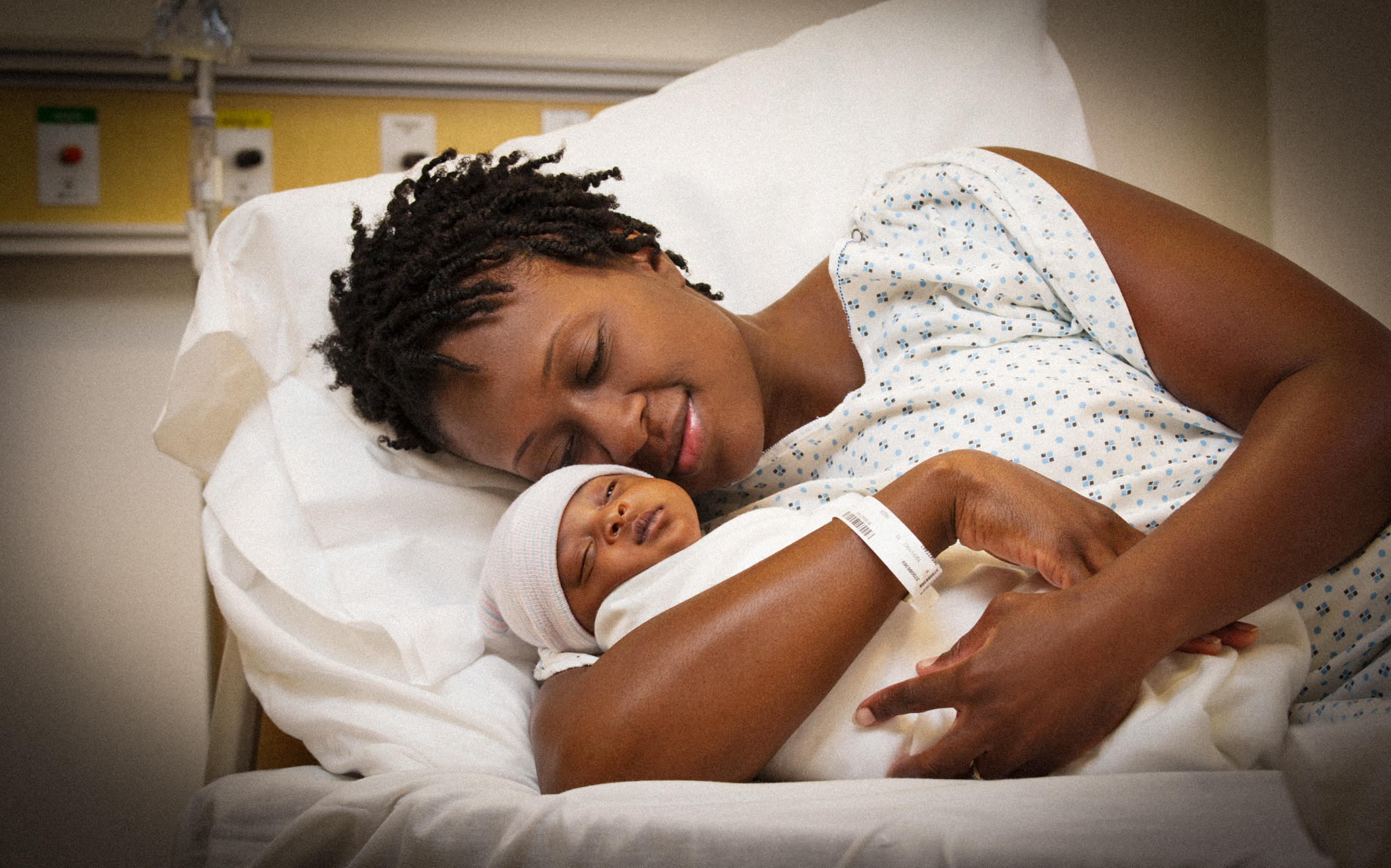Column - California Uncovered
Can California’s ‘Momnibus Act’ Create a Better Future for Black Moms and Babies?
Discovering the root cause of high rates of Black maternal and infant mortality: racism.

Few things would seem to be as noncontroversial as saving the lives of mothers and infants.
Yet Black moms and their infants have been dying at much higher rates than other moms far too long.
Researchers say that racism is the root cause for why Black women nationally are dying from pregnancy complications at three or four times the rate as white women. In California, Black infants are dying at about twice the average rate of other infants.
The health care system must move from one that devalues Black women toward one that centers their voices and addresses their concerns.
In response, the American College of Obstetricians and Gynecologists has called for a radical remaking of the health care system to confront racial bias and racism. In other words, the health care system must move from one that devalues Black women toward one that centers their voices and addresses their concerns.
A new state law, known as the “California Momnibus Act,” went into effect Jan. 1 to tackle some of the problems associated with maternal and infant mortality. The law, among other things, helps pregnant women and new moms access services to improve the health care they receive. Significantly, it expands Medi-Cal coverage for a full year postpartum and extends that coverage to the service of doulas, who are professionals trained to help pregnant women and new moms.
Having such support might have helped Tia Welton, a Black mother who has horror stories about each of the four times she has given birth. With each baby, the Cerritos mom says she was “threatened” with a Cesarean section if she didn’t deliver vaginally within an allotted time frame. Though the use of C-sections has increased, they escalate the risk of maternal mortality.
With her second baby in 2014, Welton says, the anesthesiologist stuck the epidural needle too far into her back, causing spinal fluid to leak and painful headaches that made it even more difficult for her to give birth. With her third baby, Welton was rushed into surgery before even having the chance to hold the infant after she suffered massive vaginal tearing and other injuries while delivering the 9.5-pound baby. Not to mention that the doctor and nurses were “pulling” and “yanking” the baby to try to get her out, she says. When it was time to deliver her fourth baby, she feared the worst.
“I kept thinking I might die when I deliver,” Welton says. “I didn’t know about mortality rates. If I’d known, I would’ve been more terrified.”
Today, Welton advises other Black moms on breastfeeding and other pregnancy-related issues. She’s a peer counselor at CinnaMoms, a support group for Black moms in Los Angeles and San Bernardino counties.
Since CinnaMoms was founded in 2015, the program has grown beyond its original mission to help increase breastfeeding rates among Black women. It now provides a space where the physical and mental health needs of Black moms are a priority. The organization is part of the largest network of WIC (Women, Infants and Children’s) food assistance centers for low-income moms in the country.
“Having Black staff members matters,” says K’Lynn Mitchell, CinnaMoms project coordinator.
In 2020, CinnaMoms co-founder Toncé Jackson surveyed group participants and heard many moms say doctors had failed to listen to them during labor and delivery. Some moms described how doctors had spoken “down to them” during appointments.
Statewide efforts through the years to prevent maternal and infant deaths have made California mortality rates among the lowest in the country. Still, Black women in California and elsewhere continue to die at higher rates.
Since at least 1935, when the Social Security Act became a law, Black women in the United States have been dying from pregnancy complications at three or four times the rate as white women, according to the U.S. Department of Health and Human Services.
Statewide efforts through the years to prevent maternal and infant deaths have made California mortality rates among the lowest in the country. These efforts targeted socioeconomic factors such as lack of health insurance and inadequate prenatal care. Still, Black women in California and elsewhere continue to die at higher rates. And the numbers in recent years appear to be rising in some places.
The rate of Black maternal mortality in Los Angeles County was 58.6 per 100,000 in 2013. Four years later, the ratio rose to 85.8 per 100,000. That’s compared to a ratio of 17.9 per 100,000 for all women in 2013.
Those statistics come from a 2017 report by the Los Angeles County Department of Public Health that also includes data showing that more than half of Black women with a recent live birth say they felt discriminated against because of their race or color, income and pregnancy. Other women of color also reported feeling discrimination, but not at such high rates.
“Medicine, including the field of obstetrics and gynecology, has engaged in practices that were very harmful to women of color,” the American College of Obstetricians and Gynecologists document reads.
Health organizations such as the Association of Maternal & Child Health Programs, California Health Care Foundation and the Los Angeles County Department of Public Health have cited racism as a key reason for maternal deaths. Notably, the 2017 statement on racial bias by the American College of Obstetricians and Gynecologists acknowledged past injustices done to these communities.
“Medicine, including the field of obstetrics and gynecology, has engaged in practices that were very harmful to women of color,” the document reads.
The brief mentions experimental gynecological surgery on enslaved women in the mid-1800s; the testing of high-dose hormonal contraceptives on Puerto Rican women and other women of color in the 1950s; and the unlawful sterilization from 2005 to 2013 of incarcerated women, who are disproportionately women of color.
More recent examples not mentioned in the statement are common knowledge among many women of color. A bias against Black people continues to plague the health care system.
An analysis of notes contained in the files of nearly 18,500 patients found that negative descriptions were more than 2.5 times more likely to appear in the records of Black patients than those of white patients.
A study published in the journal Health Affairs last month found that bias against Black people even seeps into their electronic health records.
Lead researcher Michael Sun used machine learning to analyze electronic health records to investigate whether health practitioners were more likely to describe patients negatively based on the patients’ race or ethnicity. The analysis of notes contained in the files of nearly 18,500 patients found that negative descriptions were more than 2.5 times more likely to appear in the records of Black patients than those of white patients.
These descriptions included words such as aggressive, agitated, angry, challenging, combative, defensive, exaggerate, refuse, resist and hysterical. The findings underscore the bias that Black people have been experiencing for years.
“This supports what they know to be true,” Sun says.
Interestingly, the study also found that notes written after the pandemic exposed racial health disparities were less likely to include negative descriptions. Researchers didn’t study the reasons why but wonder whether “social pressures may have sensitized providers to racism and increased empathy.”
“Since we saw this change, we know that it is possible for health care providers to change their practices,” says Sun, a third-year medical student at the University of Chicago.
Health inequities that have existed for years will require extensive transformations throughout health care systems at the local, state and national levels.
The California Momnibus Act makes it easier for pregnant people to access CalWORKS, a program that gives cash aid and services to eligible needy families. The new law also establishes a guaranteed income pilot program that prioritizes pregnant people. Additionally, it calls for improved data collection and empowers a task force to investigate maternal deaths.
Unfortunately, the most promising national effort is now stalled as part of the Build Back Better plan. The federal Black Maternal Momnibus Act is a package of 12 bills crafted by the Black Maternal Health Caucus. The comprehensive plan addresses socioeconomic factors; one proposed bill earmarks $175 million to improve housing, nutrition and environmental conditions.
Last year, CinnaMoms won a grant from the U.S. Department of Agriculture to expand its outreach by hiring more Black peer counselors and helping other Black women earn certification as lactation consultants. Breastfeeding support remains at the core of CinnaMoms’ offerings, but it allows program administrators the chance to address other issues to improve Black moms’ health care.
“We hope that this can be scaled throughout WIC nationwide,” says CinnaMoms co-founder Toncé Jackson, who chairs a national WIC task force on maternal mortality.
Listening to Black women is at the heart of CinnaMoms’ vision of health equity. It’s a winning formula that others working to prevent Black maternal and infant deaths should follow.
Copyright 2022 Capital & Main

-

 Latest NewsDecember 10, 2025
Latest NewsDecember 10, 2025Capital & Main, L.A. Times Win Sidney Award for Reporting on Child Farmworkers
-

 Locked OutDecember 16, 2025
Locked OutDecember 16, 2025This Big L.A. Landlord Turned Away People Seeking Section 8 Housing
-

 Column - California UncoveredDecember 12, 2025
Column - California UncoveredDecember 12, 2025They Power the U.S. Economy, But Will Struggle to Afford Health Care
-

 The SlickDecember 19, 2025
The SlickDecember 19, 2025‘The Poor Are in a Very Bad State’: Climate Change Accelerates California’s Cost-of-Living Crisis
-

 Locked OutDecember 23, 2025
Locked OutDecember 23, 2025Section 8 Housing Assistance in Jeopardy From Proposed Cuts and Restrictions
-

 Column - State of InequalityDecember 11, 2025
Column - State of InequalityDecember 11, 2025A Little Place Called Home?
-

 Locked OutDecember 17, 2025
Locked OutDecember 17, 2025Credit History Remains an Obstacle for Section 8 Tenants, Despite Anti-Discrimination Law
-

 Latest NewsDecember 22, 2025
Latest NewsDecember 22, 2025Trump’s War on ICE-Fearing Catholics

